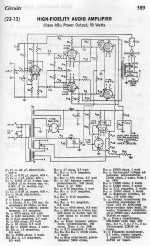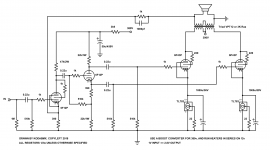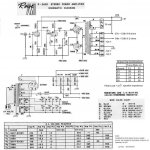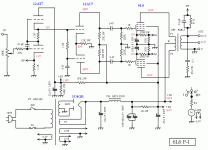Any idea of why the 6P41S failed?....the same quad has been running fine for over 6 years
6 years in use can explain why the tube has failed. Tubes have limited life time unlike semiconductors. New 6P41S cost some 2.5 €. So is it relevant to be that concerned ?
artosalo; my tubes have not failed-I was asking TheGimp why he thought his latest amp had a 6P41S failure.
huggygood; tube stages are so straightforward that I am always too lazy to draw them out in full-I normally just scribble down any semiconductor support circuitry, equalisation circuitry, etc as well as looking at the anode curves and making a note of my operating points. As I said, if you look at any of kodabmx's recent schematics, these can easily be adapted for 6P41S. From memory, I used a HT of 290V with the grids at ground potential and individual AC coupled current sinks returned to a negative supply providing 45 mA per triode connected tube. I used another Russian tube, 6Zh51P as the (differential as well) driver at about 8 mA. Because very little power was required for the large Tannoy Lancaster speakers I used a mains toroid with 6V secondary windings in parallel. The sound was deemed acceptable without GNF. You will probably want more power and will need feedback. kodabmx seems to be building an amp like this every few weeks, so you should check his posts.
huggygood; tube stages are so straightforward that I am always too lazy to draw them out in full-I normally just scribble down any semiconductor support circuitry, equalisation circuitry, etc as well as looking at the anode curves and making a note of my operating points. As I said, if you look at any of kodabmx's recent schematics, these can easily be adapted for 6P41S. From memory, I used a HT of 290V with the grids at ground potential and individual AC coupled current sinks returned to a negative supply providing 45 mA per triode connected tube. I used another Russian tube, 6Zh51P as the (differential as well) driver at about 8 mA. Because very little power was required for the large Tannoy Lancaster speakers I used a mains toroid with 6V secondary windings in parallel. The sound was deemed acceptable without GNF. You will probably want more power and will need feedback. kodabmx seems to be building an amp like this every few weeks, so you should check his posts.
Yes, like that; good use of 6F12P, I must say. I'm not familiar with 6P43P but I think it's a fairly low impedance tube. You could probably substitute 6P41S directly with some loss of gain (50%?) and increase the current somewhat. kodabmx will likely chime in.
"kodabmx will likely chime in"
yes, I have looked at some of his thread and I like his state of mind.
I will try to contact him to talk to him.
thanks piano3 😉
yes, I have looked at some of his thread and I like his state of mind.
I will try to contact him to talk to him.
thanks piano3 😉
My experience with 6P1P and 6P41S is that some end up cathode stripping on power up.
I probably should have dissected the tube, but already threw it out.
I have one amp that has been running 6 years with the original tubes in it.
A second amp has been running for over a year.
The third amp is being broken in now, and it was the one that experienced the tube failure. The tube had been baked at 300F in an oven for several hours previously in an attempt to reactivate the getter before using the tube. I normally bake tubes which do not have Bakelite bases when I get them.
I probably should have dissected the tube, but already threw it out.
I have one amp that has been running 6 years with the original tubes in it.
A second amp has been running for over a year.
The third amp is being broken in now, and it was the one that experienced the tube failure. The tube had been baked at 300F in an oven for several hours previously in an attempt to reactivate the getter before using the tube. I normally bake tubes which do not have Bakelite bases when I get them.
Last edited:
Come to think of it, I seem to remember that the 6P41S takes a long time to settle down even though I always run unused tubes with heaters only for half an hour before risking turning on the HT.
I've made some amplifiers (maybe a ~10-11!) With 6P41S and I can not remember any specific work problem! I'm surprised to read about the problems with 6P41S!
In the pentod connection it is actually the EL86 on the steroids, and coupled as pseudo triode (and UL!) works very stable to ~ 380-400V.
Permanently submits much larger anode dissipation than the above 14W from the data sheet, I would say up to ~ 18-20W.
Some of the amplifiers have been working for more than 10 years (for guitar) without replacing the output 6P41S!
In the pentod connection it is actually the EL86 on the steroids, and coupled as pseudo triode (and UL!) works very stable to ~ 380-400V.
Permanently submits much larger anode dissipation than the above 14W from the data sheet, I would say up to ~ 18-20W.
Some of the amplifiers have been working for more than 10 years (for guitar) without replacing the output 6P41S!
davorin, I don't think anyone is reporting serious problems, just that long unused tube can be moderately gassy for the first few hours.
6 years in use can explain why the tube has failed. Tubes have limited life time unlike semiconductors. New 6P41S cost some 2.5 €. So is it relevant to be that concerned ?
Semiconductors have limited lifetime as well. They are measured in FITs (Failures In Time) measured in 10e9 hrs per FIT.
The failure rates are several orders of magnitude greater than that of tubes, but they do have well defined failure mechanisms.
i'm ready to convert a new ami/rowe r4359 to 6p3s-e
I will probably need help to increase the voltage gain of the inverter stage
because of the difference in gain between 7591 7868 and 6p3s-e.
if it amuses someone to come play with me, I'm interested
i have all schematics for this amp
I will probably need help to increase the voltage gain of the inverter stage
because of the difference in gain between 7591 7868 and 6p3s-e.
if it amuses someone to come play with me, I'm interested
i have all schematics for this amp
would any of you have a nice 6l6gc scheme to suggest?
the base (for power supply and opt 6.6k)
the base (for power supply and opt 6.6k)
An externally hosted image should be here but it was not working when we last tested it.
would any of you have a nice 6l6gc scheme to suggest?
the base (for power supply and opt 6.6k)
I'm told this is an excellent design, from the RCA tube manuals of the late 1950s.

I put a simplified version of this circuit into LTspice, using 6L6GC instead of 7027A, a model for a Dynaco A-470 OPT, and a simpler 6SN7 cathodyne front end instead of the 7199 used here. I also used 6AC7 pentodes for the LTP, instead of 6CB6. The result was very promising. I think this could be a very good amplifier design.
The only problem I found was that it has too-high input sensitivity without a global NFB loop applied (with only the local feedback loops). I got 44mA to 1 watt output.
I'm looking at some RCA schemes and there are some that are simple and effective
but I'm looking for something more modern.
what annoys me is that I do not know simulations, I am forced to look for tried schemas and known as being musical and stable.
I'm just looking for a thin, full-bodied and with a medium a little forward for the voices.
thank you for your help
but I'm looking for something more modern.
what annoys me is that I do not know simulations, I am forced to look for tried schemas and known as being musical and stable.
I'm just looking for a thin, full-bodied and with a medium a little forward for the voices.
thank you for your help
I also specify that I have a stock of pentode, triode and triode / pentode small signals at home, while old stock new that a friend gave me
The only problem I found was that it has too-high input sensitivity without a global NFB loop applied (with only the local feedback loops). I got 44mA to 1 watt output.
Decrease R4. but why would you want it without the global loop?
As an option, 6AU6 for the first stage, 6AH6 for driver tubes. Nice cheap sleepers. Cheap 7-pin sockets. Also, 6AU6 triode strapped for Concertina.
Or Soviet 6J4P for the first stage, 6J5P for the rest. Even cheaper, but still nice.
- Home
- Amplifiers
- Tubes / Valves
- 6P41s vs 7868


